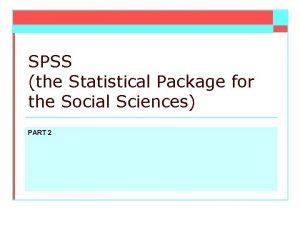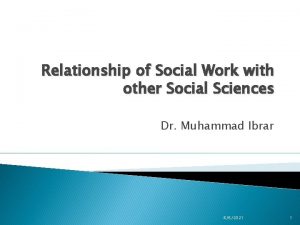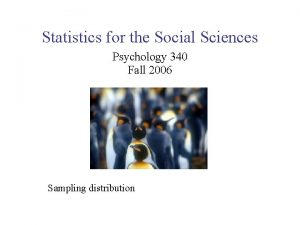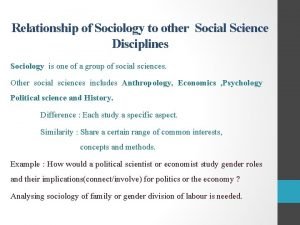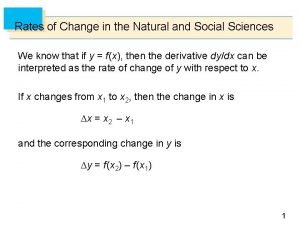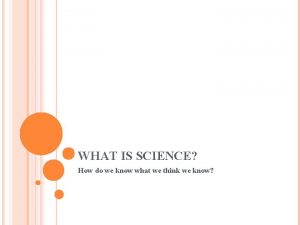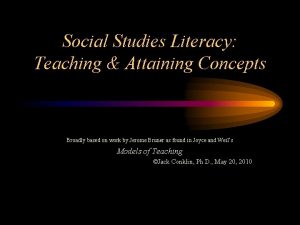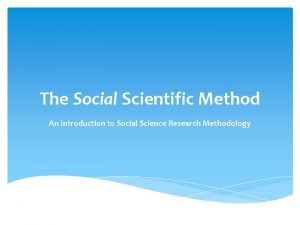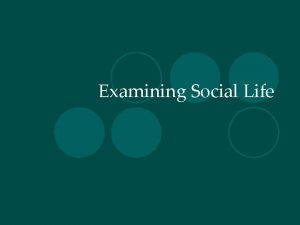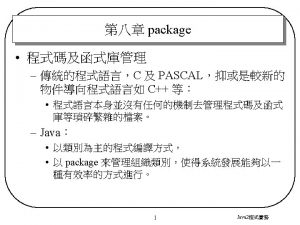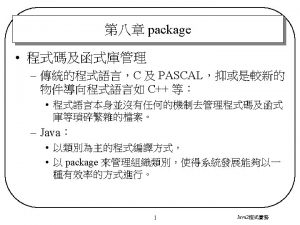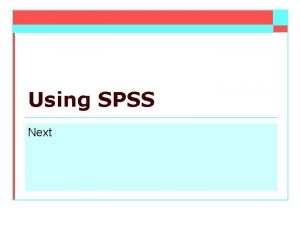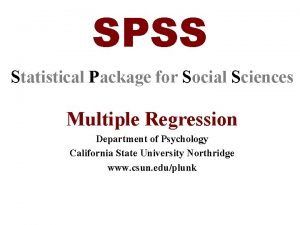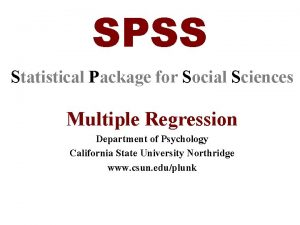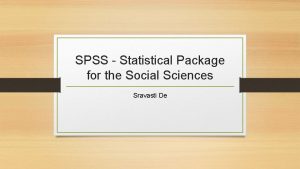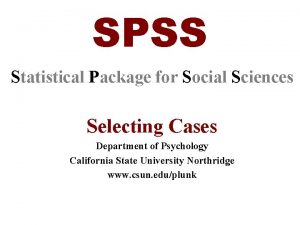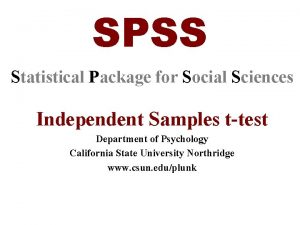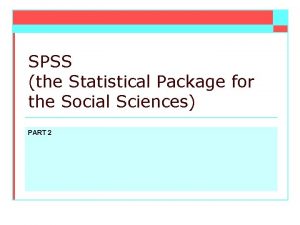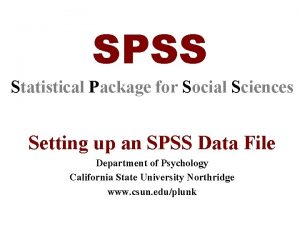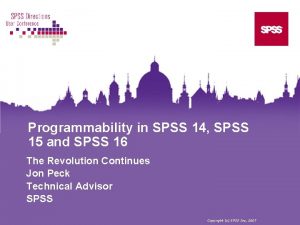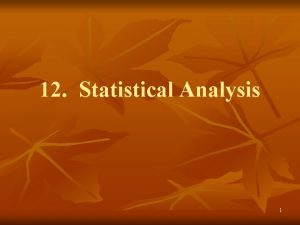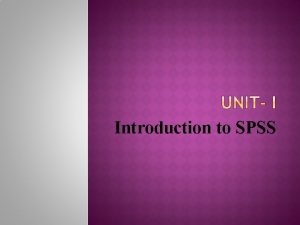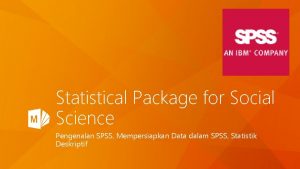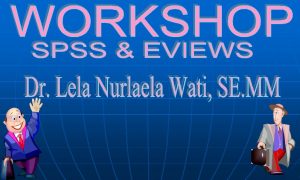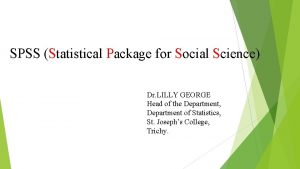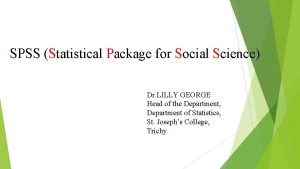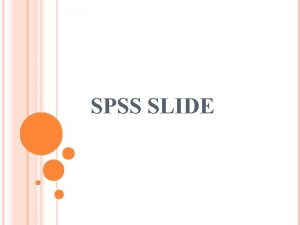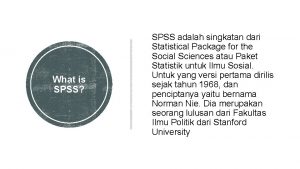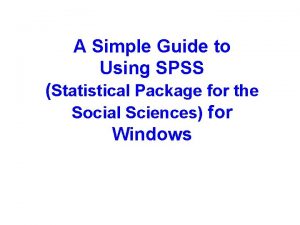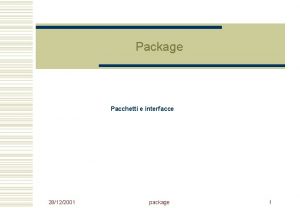SPSS the Statistical Package for the Social Sciences







































- Slides: 39

SPSS (the Statistical Package for the Social Sciences) PART 2

Lesson objectives o Recap SPSS n Data entry o o n o o Data view Variable view Descriptive analysis Determining reliability Inferential Statistics with SPSS

Inferential Statistics o o Based on the assumption that the sample is random Types of tests n n n Chi Squared Correlation T test

Example research Purpose : To determine if V-ROTAN method of teaching will lead to higher achievement and learning satisfaction among visual learners

Design Independent Variable Learning styles o o INTERVENTION Teaching method Dependent Variable Achievement Satisfaction Population: EDU Research student (100) Sample ( chosen at random, 3 lessons taught by the same person using the ‘method’) n n Class 1 (40) Class 2 (40)

Instruments o Learning style inventory n n o Questionnaire n n o Scores will determine learning styles Can categorize as visual, tactile or auditory Satisfaction regarding the teaching method higher score – higher lesson satisfaction Test n Scores will determine achievement

Establishing causality o o To establish causality, one must use an experimental or quasiexperimental design. True experimental designs include: n n n Pre-test/Post-test control group design Solomon Four-Group design Post-test only control group design

Threats in experimental research -Definite weakness + controlled ? Source of concern

What to describe? o Descriptive stats n n o Age Gender Program Learning styles Cross tabulate? n Gender and learning styles

Significance o o If significant, unlikely to have occurred by chance (kebetulan) there is statistical evidence that there is a difference, a correlation, an association between etc….

Probability of something happening? o Probability that you will die someday = _____?

Significance level o o o Significance levels show you how likely a result is due to chance. The most common level, used to mean something is good enough to be believed, is 0. 95 The finding has a 95% chance of being true. No statistical package will show you "95%" or ". 95" to indicate this level. Instead it will show you ". 05, " meaning that the finding has a five percent (. 05) chance of not being true, which is the converse of a 95% chance of being true. To find the significance level, subtract the number shown from one. For example, a value of ". 01" means that there is a 99% (1 -. 01=. 99) chance of it being true

Hypothesis testing o The Null hypothesis states there is no true difference/no relationship between parameters in the population n We reject or fail to reject the null hypothesis o o It is rejected only when it becomes evidently false, that is, when the researcher has a certain degree of confidence, usually 95% to 99%, that the data do not support the null hypothesis Example n There is no significant difference between the mean test scores of visual and tactile learners

Hypothesis testing o YOU ALWAYS TEST THE NULL HYPOTHESIS!

Significance o Test of significance n n To decide whether to reject the null hypothesis Select probability o o n 5 out of 100 times the difference did not occur by chance ( Significance level: 0. 05) 1 out of 100 times the difference did not occur by chance ( Significance level: 0. 01) Confidence level? o 95% or 99%

Example o Null hypothesis n o o Significance level : 0. 05 Test statistic n o There is no relationship between variables. . Probability value 0. 009 or Sig. 0. 009 (smaller than 0. 05) What does that mean? n n n very unlikely that there’s no relationship between the variables Variables not independent of each other REJECT Null hypothesis

Example o Null hypothesis n o o Significance level : 0. 01 Test statistic n o There is no relationship between variables. . Probability value 0. 12 or Sig. 0. 12(greater than 0. 01) What does this mean? n n n Higher likelihood that there’s no relationship between the variables Variables are independent of each other Fail to reject (accept? ) Null hypothesis

Let’s get on with inferential statistics

Now. . What to infer? o o o Independence/ Association Correlation Differences

Independence test –Chi squared o Chi squared test is used in situations where you have two categorical variables n n o Gender and employment sector Gender and learning styles Chi-square test of independence tests the null hypothesis that there is no association between the two variables

Example: Test for independence o Gender n n o Learning styles n n n o Female Male Visual Tactile Auditory Null Hypothesis: No association between gender and learning styles

Using SPSS for chi squared o Click n Analyze o Descriptive n Crosstabs o Statistics

Using SPSS for chi squared o o o Low chi squared statistic Sig. 961 Fail to reject the null hypothesis There is no association… Variables independent of each other

Correlation o o Measure of the linear relationship between two variables. A correlation coefficient has a value ranging from -1 to 1. Values that are closer to the absolute value of 1 indicate that there is a strong relationship between the variables being correlated whereas values closer to 0 indicate that there is little or no linear relationship. The sign of a correlation coefficient describes the type of relationship between the variables being correlated. n n A positive correlation coefficient indicates that there is a positive linear relationship between the variables: as one variable increases in value, so does the other. A negative value indicates a negative linear relationship between variables: as one variable increases in value, the other variable decreases in value.

Example: Correlation o o Correlation between learning styles and test scores Correlation between learning styles and satisfaction

Correlation in SPSS o o Start at the Analyze menu. Select the Correlate option from this menu. You will see three options for correlating variables: n n n o Bivariate Partial Distances. The bivariate correlation is for situations where you are interested only in the relationship between two variables


Correlation in SPSS o Then, consider is the type of correlation coefficient. n n o Pearson's is appropriate for continuous data Kendall's tau-b and Spearman's, are designed for ranked data. The choice between a one and two-tailed significance test in the Test of Significance box should be determined by the hypothesis you are testing n n if you are making a prediction that there is a negative or positive relationship between the variables, then the onetailed test is appropriate if you are not making a directional prediction, you should use the two-tailed test (there is not a specific prediction about the direction of the relationship between the variables)

Output

Output o Correlation is not statistically significant

Let’s check for significant difference Differences between test scores of the groups of learners

Differences: Using t test o The t test is a useful technique for comparing mean values of two sets of numbers. n o Statistic for evaluating whether the difference between two means is statistically significant. t tests can be used either n n to compare two independent groups (independent-samples t test) to compare observations from two measurement occasions for the same group (paired-samples t test).

Remember t test - tests the null hypothesis / that there is no difference …

t test o o If you are using the t test to compare two groups, the groups should be randomly drawn from normally distributed and independent populations. Using SPSS n Analyze o Compare Means One-Sample T test. . . Independent-Samples T test. . . Paired-Samples T test. . .

Types of t-test o The one-sample t test is used compare a single sample with a population value. n o The independent-sample t test is used to compare two groups' scores on the same variable. n o Example, a test could be conducted to compare the average test scores of U 5 C with a value that was known to represent the whole EDU 540 population. Example : Compare the test scores of U 5 C and PKPG to evaluate whethere is a difference in their scores. The paired-sample t test is used to compare the means of two variables within a single group. n Example, it could be used to see if there is a statistically significant difference between test 1 and test 2 among the members of U 5 C

Using SPSS : t test

Output o Notice the two parts of the output n n o Equal variances assumed Equal variance not assumed Which to use? n n Look at Levene’s test for equality of variance If small Sig. - groups have unequal variances

Output o o t-statistics is -6. 024 Sig. level : . 000 The significance level tells us that the probability that (there is no difference between visual and tactile learners) – the “NULL” is very small Hence, there is a significant difference in the test scores between visual and tactile learners

Have fun with SPSS! Proceed to Qualitative Analysis and Ethics in Research
 Statistical package for social science
Statistical package for social science Human science tok
Human science tok Relation of social work with other social sciences
Relation of social work with other social sciences Statistics for social sciences
Statistics for social sciences Social sciences citation index journal list
Social sciences citation index journal list Social science definition
Social science definition Rates of change in the natural and social sciences
Rates of change in the natural and social sciences Ns grade 6 term 2
Ns grade 6 term 2 College of humanities and social sciences
College of humanities and social sciences Social sciences examples
Social sciences examples Social sciences examples
Social sciences examples Education desk social sciences uva
Education desk social sciences uva Education desk social sciences uva
Education desk social sciences uva Scientific method in social sciences
Scientific method in social sciences Humanities and social sciences
Humanities and social sciences Importance of social science
Importance of social science Sociology
Sociology Site:slidetodoc.com
Site:slidetodoc.com Cleveland arts & social sciences academy
Cleveland arts & social sciences academy Social thinking adalah
Social thinking adalah Social thinking social influence social relations
Social thinking social influence social relations Iso 22301 utbildning
Iso 22301 utbildning Novell typiska drag
Novell typiska drag Nationell inriktning för artificiell intelligens
Nationell inriktning för artificiell intelligens Ekologiskt fotavtryck
Ekologiskt fotavtryck Varför kallas perioden 1918-1939 för mellankrigstiden
Varför kallas perioden 1918-1939 för mellankrigstiden En lathund för arbete med kontinuitetshantering
En lathund för arbete med kontinuitetshantering Underlag för särskild löneskatt på pensionskostnader
Underlag för särskild löneskatt på pensionskostnader Personlig tidbok
Personlig tidbok Anatomi organ reproduksi
Anatomi organ reproduksi Vad är densitet
Vad är densitet Datorkunskap för nybörjare
Datorkunskap för nybörjare Boverket ka
Boverket ka Att skriva debattartikel
Att skriva debattartikel Delegerande ledarstil
Delegerande ledarstil Nyckelkompetenser för livslångt lärande
Nyckelkompetenser för livslångt lärande Påbyggnader för flakfordon
Påbyggnader för flakfordon Arkimedes princip formel
Arkimedes princip formel Svenskt ramverk för digital samverkan
Svenskt ramverk för digital samverkan Urban torhamn
Urban torhamn
